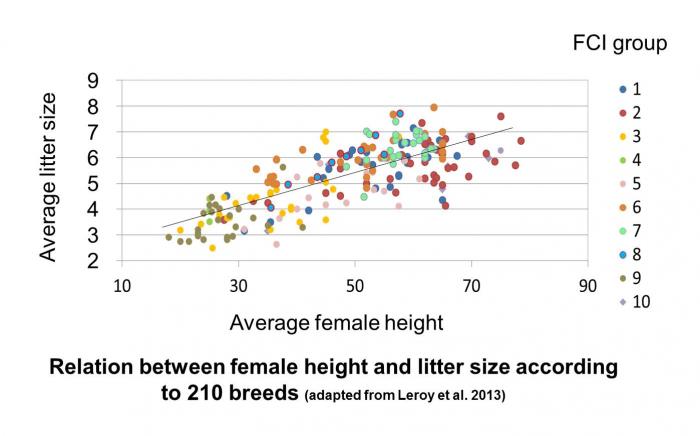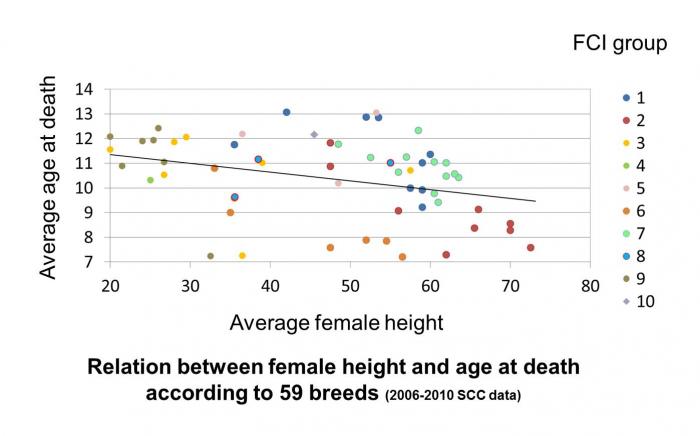Why size matters
A few days ago, I have been sent this graph published in 2014 by the excellent Information is Beautiful website. In this infographic, popularity (based on AKC 2011 registrations) was plotted against a synthetic index based on various information related to health, longevity, cost and convenience (data can be found there). Of course, the choice on variable and data source can be discussed (as always), yet I was surprised, at first sight, to see how large or giant breeds where generally poorly rated in comparison to other breeds.
When thinking on variables chosen, such results should however not be surprising, as large dogs are indeed expected to eat more, to cost more, and to have shorter life expectancy (we will come to that later). Large dogs have also predispositions to specific disorders such as hip and elbows dysplasia, but actually there are also conditions associated with small body size (Asher et al. 2009). Anyway, it is amazing to see how health and breeding parameters are impacted by dog size. A funny example of this is related to a preliminary study we made with colleagues of dog canine genetics unit of Rennes on dog prolificacy (see below). We tried to identify genes that could impact the litter size, in a genome wide association study covering 37 breeds. We actually identified several genome areas significantly related to difference in litter size. Yet, actually all those genome areas were already known to be involved in dog size, both parameters being largely correlated, in relation to increased size of uterus for instance. Note that independently to dog size, FCI breed groups appeared to have a significant impact on litter size, in agreement with Borge et al. (2011).
Similarly, there is the well-known relationship between breed size and average longevity, although not as clear as for prolificacy, as illustrated below. In a recent study, Kraus et al. (2013) discussed extensively the reasons why breeds with large body size show shorter lifespan. According to those authors it seems there is a strong correlation between size and aging rate (i.e. increased risk of dying when dogs grow older). It may be eventually due to the fact that age-related diseases are delayed in small breeds, or to specific lethal conditions in large dogs.
Anyway, this increased aging rate may impact dog reproductive carriers, and in a survey on breeding practice (Leroy et al. 2007), breeders from the molossoid FCI 2nd group (including breeds of large size with short lifespan as illustrated by the previous figure) reported ending the reproductive career of their dams and sires earlier (6.1 and 7.3 against 6.7 and 8.4 years on average, respectively). On the other hand, as small dogs reach adult weight earlier (Hawthorne et al. 2004), terrier and companion dogs were reported in the same survey to begin their reproductive career earlier (for dams: 2.2 against 2.4 years on average, for sires 1.6 against 2.1 years on average). In relation to an earlier maturity and longer lifespan, smaller dogs are expected to have longer reproductive career, this, and the low prolificacy illustrated earlier will explain why on average in small dogs breeds, male and female reproducers may be expected to produce more litters during their life.
Selection in dog has led to breeds with an incredible variation in body size, which has important consequences for their health and welfare, as well as for the way they are bred. It could be also interesting to investigate, in a next post, how the perception of the public on dog size may evolve over time and impact the breeds.
References
- Asher L., Diesel G., Summers J.F., McGreevy P.D., Collins L.M. (2009) Inherited defects in pedigree dogs. Part 1: disorders related to breed standards. The veterinary Journal 182(3), 402-411.
- Borge, K.S., Tonnessen, R., Nodtvedt, A., Indrebø, A., 2011. Litter size at birth in purebred dogs – A retrospective study of 224 breeds. Theriogenology 75, 911–919.
- Kraus, C., Parvard, S., Promislow, D.E.L., 2013. The size-life span trade-off decomposed: Why large dogs die young. American Naturalist 181, 492–505.
- Hawthorne, A. J., D. Booles, P. A. Nugent, G. Gettinby, and J. Wilkinson. 2004. Body-weight changes during growth in puppies of different breeds. Journal of Nutrition 134:2027S–2030S.
- Leroy, G., Verrier, E., Wisner-Bourgeois, C., Rognon, X., 2007. Breeding goals and breeding practices of French dog breeders: Results from a large survey. Revue de Médecine Vétérinaire 158, 496–503.
- Leroy G., Hedan B., Andre C. (2013) Genetic trends and genome wide association study for litter size in dog. 7th International Conference on Advances in Canine and Feline Genomics. Boston.
Thanks to Gull as well as to Knowledge is Beautiful, whose latest publications can be found here.
Credit picture: I. Horvath / SCC / AgroParisTech
 Donate
Donate




0 Comments
Recommended Comments
There are no comments to display.